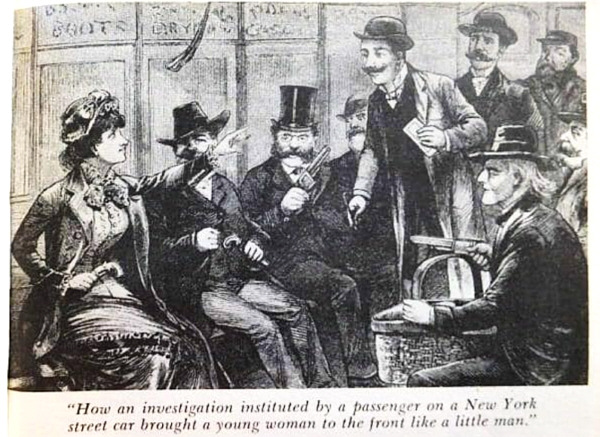

AmmoLand Cited in DC Mass
Transportation Second Amendment Case

Weingarten, 1884 New York Street Car Scene Shows Carry of Pistols Common Before 1911.
Ammoland (September 18, 2022) (Exhibit 6, hereto.)
Click to enlarge image
By Dean Weingarten. Jan 23, 2023
Article Source
AmmoLand has been cited in the Angelo v. District of Columbia case. The case is a challenge of the constitutionality of a ban on carrying arms on public transportation in the District of Columbia.
The AmmoLand article is cited, and the illustration is shown, on page 27 of the Memorandum of Points and Authorities submitted to the United States District Court for the District of Columbia, on October 30, 2022.
The article in AmmoLand about the illustration of the street car scene in New York came about in this manner:
The illustration was published on Freerepublic.com as part of a discussion about a proposed NY law to restrict ammunition by a Freeper with the screen name of Ruy Dias de Bivar, on post #24.
This correspondent inquired of the provenance of the image, and learned it came from The Remington Historical Treasury of American Guns, published in 1966.
This correspondent obtained a copy of the Remington Historical Treasury of American Guns, which credited the New York Public Library Picture Collection. The New York Library Picture Collection was contacted. They found a somewhat later version of the image was published in the Police Gazzette, on April 19, 1884.
A brother of this correspondent urged him to contact the attorneys in the case of Angelo v. D.C. The attorneys were contacted and were glad to receive the information.
On October 30, 2022, the Memorandum of Points and Authorities was submitted to the DC court electronically.
From the Memorandum:
In any event, Bruen is concerned not with what was common or uncommon social practice, but with the history and tradition of firearms regulation. And the quote DC posits, wherever it might have come from, assuming it actually came from somewhere, has no relation to carrying on transportation vehicles. Anecdotal evidence indicates gun carrying on public transportation was not unusual. The following illustration in the April 19, 1884, Police Gazette shows several passengers in a New York City horsecar with handguns. See Dean Weingarten, 1884 New York Street Car Scene Shows Carry of Pistols Common Before 1911, Ammoland (September 18, 2022) (Exhibit 6, hereto.)
For those interested in the details of the case, the memorandum is well worth reading. Those who have a pacer account can read it now. It should become available shortly at michellawyers.com and at courtlistener.com.
At 45 pages long, it is too much to post on AmmoLand. Here is part of the Summary of Argument:
Under these facts, Supreme Court precedent says that is sufficient to confer standing on them to contest the Metro ban. Plaintiffs meet all preliminary injunction requirements. They are likely to prevail on the merits because DC failed to point to established, representative "distinctly similar" restrictions from the founding era banning firearm carry on public transportation vehicles. Public transportation arose shortly after ratification of the Second Amendment and grew throughout the 19th Century to include ferry service, riverboats, omnibuses, commuter rail, interstate passenger rail and street cars. In the early 20th Century subway service developed. Defendants point to no laws prohibiting gun carry on these conveyances during the relevant period, much less an established tradition of banning gun carry on public transportation. That dooms DC Code § 7-2509.07(a)(6).
The Metro system is not analogous to schools or the Capitol grounds. The mere fact minors and government workers are present does not convert a public place into a sensitive place. If guns could be banned everywhere children or government workers might be, in no place in the city could Plaintiffs exercise their Second Amendment right to carry a firearm for personal protection. The Court should eschew opposing parties' invitation to engage in interest balancing and focus instead on the Supreme Court's requirement that DC demonstrate its regulation is consistent with the Nation's historical tradition of firearms regulation. See New York State Rifle & Pistol Ass'n v. Bruen,142 S.Ct 2111 (2022) (hereinafter "Bruen"). The District has not met that requirement. The few place restrictions DC and amici point to, other than the voting precincts, legislative assemblies, and courts Bruen discussed, were enacted in the late 19th Century and thus are far removed from the Second Amendment's adoption, were enacted in only a few states and territories, were not long standing, and most importantly did not ban gun carry on public transportation.
The Bruen decision, written by Supreme Court Justice Clarence Thomas, is clear. If restrictions on the exercise of rights protected by the Second Amendment were not common and accepted near the time of ratification of the Amendment or with less importance, near the time of ratification of the Fourteenth Amendment, they are unconstitutional.
This correspondent expects the ban on carry on public transportation will be found to be unconstitutional.
©2023 by Dean Weingarten: Permission to share is granted when this notice and link are included.
![]()

























